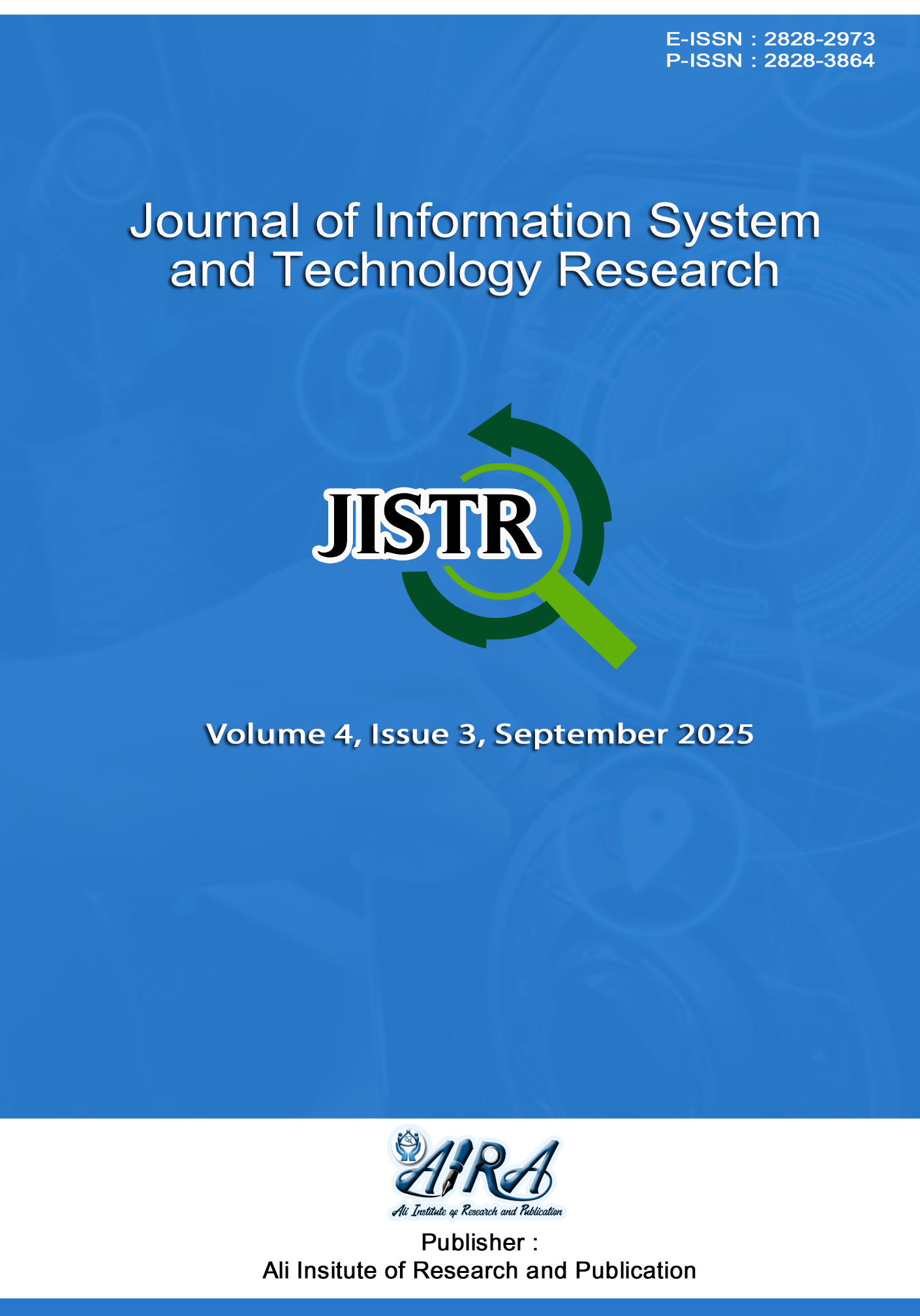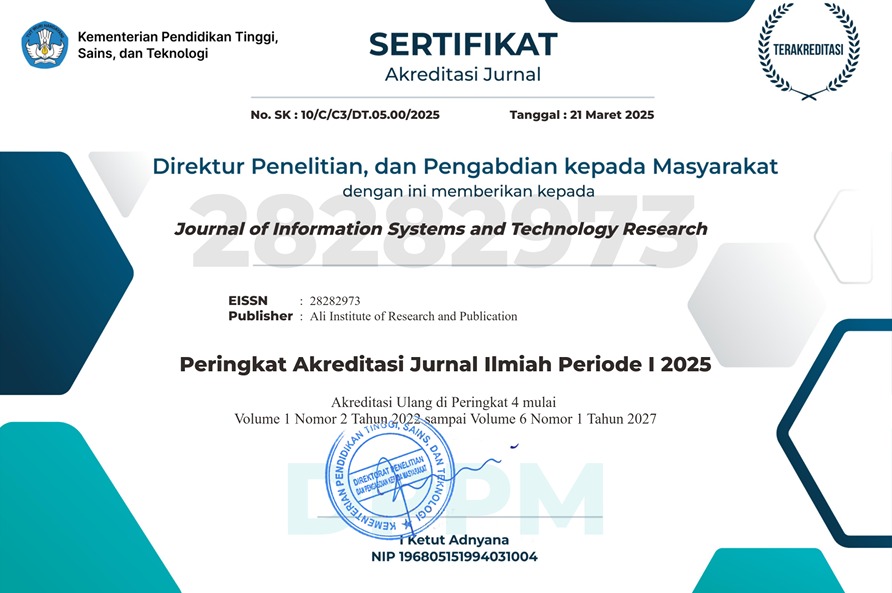Forecasting USD to Rupiah Exchange Rate with the Fuzzy Time Series Singh Approach
DOI:
https://doi.org/10.55537/jistr.v4i3.1238Keywords:
exchange rate, mape, fuzzy time series singh, forecastingAbstract
The exchange rate plays a crucial role in determining a country's economic stability, especially for countries like Indonesia that rely heavily on international trade. In recent years, the fluctuations in global currency values have intensified, particularly after the trade war between the United States and China began in 2018. These fluctuations have significantly impacted the exchange rate between the Indonesian Rupiah and the US Dollar, which in turn affects the competitiveness of Indonesian exports, increases the cost of imports, and influences key economic decisions made by investors, importers, and exporters. The problem of this research lies in the challenge of predicting exchange rate movements amidst economic uncertainty and currency volatility. This study aims to address this problem by forecasting the exchange rate of the Indonesian Rupiah against the US Dollar using the Fuzzy Time Series Singh method. This method is chosen due to its ability to capture complex data patterns with high accuracy and simpler computational requirements. The primary objective of the research is to evaluate the effectiveness and accuracy of the Fuzzy Time Series Singh method in predicting the exchange rate of the Rupiah against the US Dollar. The results of this study show that the forecasting model achieved an accuracy rate with a MAPE value of less than 10%, indicating that the method can provide highly reliable predictions, which can assist economic actors in making better-informed decisions in the face of currency volatility.
Downloads
References
[1] T. Trimono, V. Nathania, and A. R. Ramadhanti, “Pengaruh Nilai Tukar Rupiah terhadap Dolar Amerika Serikat dan Jumlah Wisatawan Asia Tenggara,” Prosiding Seminar Nasional Sains Data, vol. 3, no. 1, pp. 190–199, 2023, doi: 10.33005/senada.v3i1.113.
[2] S. U. Rahmah, A. P. Putri, S. Siswanto, and A. Kalondeng, “Peramalan Nilai Tukar Rupiah Terhadap Dolar Singapura dengan Pendekatan Average Based Fuzzy Time Series Markov Chain,” Faktor Exacta, vol. 17, no. 1, May 2024, doi: 10.30998/faktorexacta.v17i1.21164.
[3] Y. Meng, Bo. Gao, Yuning. Zhang, Tao. Yi, Jiabai. Zang, “The US–China relations and the impact of the US–China trade war: Global value chains analyses,” Econ. Anal. Policy, vol. 87, pp. 1896–1908, 2025, doi: https://doi.org/10.1016/j.eap.2025.07.038.
[4] T. Yang, “Volatility characteristics of stock markets during the US-China trade war,” Int. Rev. Econ. Financ., vol. 102, no. June, p. 104335, 2025, doi: 10.1016/j.iref.2025.104335.]
[5] R. Amalia and N. Az-zahra, “Analisis Dampak Perang Dagang AS-China Terhadap Perekonomian di Indonesia,” vol. 1, no. 4, 2025.
[6] T. Rastuti and A. A. D. Khoirudin, “Politik Hukum Indonesia dalam Menghadapi Retaliasi Perang Dagang China terhadap Amerika Serikat Berdasarkan Prinsip Proteksionisme,” Litigasi, vol. 26, no. 1, pp. 26–66, 2025, doi: 10.23969/litigasi.v26i1.15157.
[7] I. Sulistiani and L. Riani, “"Transformasi Pendidikan Ekonomi Dalam Membangun Inovasi Model Analisis Permasalahan Perdagangan Internasional Terkait Konflik Dagang Amerika Serikat-Tiongkok Bagi Indonesia,” 2024.
[8] A. I. Sakti et al., “Implementasi Artificial Neural Network (ANN) dalam Memprediksi Nilai Tukar Rupiah terhadap Dolar Amerika,” Euler J. Ilm. Mat. Sains dan Teknol., vol. 12, no. 2, pp. 124–130, 2024, doi: 10.37905/euler.v12i2.26654.
[9] D. Yulia Hidayah, “Peramalan Nilai Tukar Rupiah terhadap Dollar Amerika dengan Metode Fuzzy Time Series (FTS) Markov Chain,” UNNES Journal of Mathematics, vol. 10, no. 2, pp. 85–95, 2021.
[10] S. Y. Amalutfia and Moh. Hafiyusholeh, “Analisis Peramalan Nilai Tukar Rupiah Terhadap Dollar dan Yuan Menggunakan FTS-Markov Chain,” Vygotsky, vol. 2, no. 2, p. 102, 2020, doi: 10.30736/vj.v2i2.258.
[11] T. Trimono, A. Muhaimin, and N. Selayanti, “Forecasting the number of traffic accidents in Purbalingga Regency on 2023 using time series model,” vol. 8, pp. 419–427, 2024.
[12] A. T. Damaliana, K. M. Hindrayani, and T. M. Fahrudin, “Hybrid Holt Winter-Prophet method to forecast the num-ber of foreign tourist arrivals through Bali’s Ngurah Rai Airport,” Internasional Journal of Data Science, Engineering, and Anaylitics, vol. 3, no. 2, pp. 21–32, 2024, doi: 10.33005/ijdasea.v3i2.8.
[13] A. T. Mustafa and O. S. A. Al-yozbaky, “Forecasting Energy Demand and Generation Using Time Series Models : A Comparative Analysis of Classical , Grey , Fuzzy , and Intelligent Approaches,” Franklin Open, p. 100350, 2025, doi: 10.1016/j.fraope.2025.100350.
[14] A. T. Damaliana, A. Muhaimin, and P. A. Riyantoko, “Peramalan Lonjakan Kasus Harian Covid-19 Di Indonesia Dengan Model Arima,” Prosiding Seminar Nasional Sains Data, vol. 3, no. 1, pp. 184–189, 2023, doi: 10.33005/senada.v3i1.112.
[15] Z. Shuai, Li., Cheng, Zhao., Jie, “STNet: Seasonal-trend network for multivariate time series forecasting,” Neurocomputing, vol. 655, no. 131407, 2025, doi: https://doi.org/10.1016/j.neucom.2025.131407.
[16] M. Idhom, A. Fauzi, T. Trimono, and P. Riyantoko, “Time Series Regression: Prediction of Electricity Consumption Based on Number of Consumers at National Electricity Supply Company,” TEM Journal, vol. 12, no. 3, pp. 1575–1581, 2023, doi: 10.18421/TEM123-39.
[17] O. Chaffard, M. Cavazza, and H. Prendinger, “Highlights Enhancing Large Language Models for Bitcoin Time Series Forecasting Enhancing Large Language Models for Bitcoin Time Series Forecasting,” 2025, doi: 10.1016/j.knosys.2025.114449.
[18] M. Idhom and S. M. Huda, “Sistem Informasi Peramalan Penjualan Dengan Metode Least Square Studi Kasus : Cv. Agp Computer,” Scan : Jurnal Teknologi Informasi dan Komunikasi, vol. 12, no. 1, pp. 25–34, 2017, doi: 10.33005/scan.v12i1.879.
[19] M. Pio Hidayatullah, H. Yozza, and I. Rahmi Hg, “PENERAPAN METODE FUZZY TIME SERIES MARKOV CHAIN DALAM MERAMALKAN NILAI TUKAR RUPIAH TERHADAP DOLAR AMERIKA SERIKAT (AS),” Jurnal Matematika UNAND, vol. 12, no. 2, pp. 121–134.
[20] S. R. Singh, “A computational method of forecasting based on fuzzy time series,” Math Comput Simul, vol. 79, no. 3, pp. 539–554, 2008, doi: 10.1016/j.matcom.2008.02.026.
[21] D. Monica and D. Suhaedi, “Analisis Model Fuzzy Time Series Chen, Cheng dan Singh pada Data Trend A R T I C L E I N F O,” pp. 81–92, 2024.
[22] A. P. Zahrani, “PERBANDINGAN HASIL PREDIKSI PEMAKAIAN AIR PDAM DI DKI JAKARTA MENGGUNAKAN FUZZY TIME SERIES LEE DAN FUZZY TIME SERIES SINGH,” universitas andalas, 2023.
[23] “Kurs Transaksi Bank Indonesia,” Bank Indonesia. [Online]. Available: https://www.bi.go.id/id/statistik/informasi-kurs/transaksi-bi/Default.aspx
[24] P. Chuyi, Zhang. Deshan, Sun. Kuo, Pang. Li, Zou. Luis, Martínez. Witold, “A high-order hesitancy fuzzy time series model based on improved cumulative probability distribution approach and weighted fuzzy logic relationship,” Inf. Sci. (Ny)., vol. 717, p. 122262, 2025, doi: https://doi.org/10.1016/j.ins.2025.122262.
[25] H. Kumar, Niteesh. Kumar, “A novel hybrid fuzzy time series model for prediction of COVID-19 infected cases and deaths in India,” ISA Trans., vol. 124, pp. 69–81, 2022, doi: https://doi.org/10.1016/j.isatra.2021.07.003.
[26] W. Idhom,Mohammad. Fauzi, Akhmad. Muhaimin, Amri. Caesarendra, “Evaluation of CART and XGBoost Methods on Customer Loan Risk Prediction Based on Consumer Behavior,” TEM J., vol. 14, no. 3, pp. 2640–2651, 2025, doi: 10.18421/TEM143.
[27] M. G. Z. Ghenaati, Bahram. Reza Nikoo, “Long-term forecasting of monthly reservoir inflow using deep and machine-learning-based algorithms,” Eng. Appl. Artif. Intell., vol. 161, p. 112175, 2025, doi: https://doi.org/10.1016/j.engappai.2025.112175.
[28] A.T. Damaliana, A.Muhaimin, D.A. Prasetya, “FORECASTING THE OCCUPANCY RATE OF STAR HOTELS IN BALI,” vol. 12, no. 1, pp. 24–33, 2024, doi: 10.14710/JSUNIMUS.
[29] S. Hasibuan, Y. Asdi, and A. Nazra, “Peramalan Harga Minyak Mentah Dunia Menggunakan Metode Fuzzy Time Series Logika Singh,” Jurnal Matematika UNAND, vol. 13, no. 1, pp. 66–74, 2024, doi: 10.25077/jmua.13.1.66-74.2024.
[30] S. Pant, Shivani., Kumar, “PIFS, ARC and Markov model based hybrid method for fuzzy time series forecasting,” Expert Syst. Appl., vol. 279, p. 127510, 2025, doi: https://doi.org/10.1016/j.eswa.2025.127510.
[31] L. X. HUI and B. YUSOFF, “EXCHANGE RATE FORECASTING USING FUZZY TIME SERIES-MARKOV CHAIN,” Universiti Malaysia Terengganu Journal of Undergraduate Research, vol. 3, no. 3, 2021, doi: 10.46754/umtjur.v3i3.230.
[32] M. A. Bakawu, M. Alhaji Bakawu, A. Buba Tarajo, and A. Malik, “Forecasting Quarterly Exchange Rates Using Fuzzy Time Series: A Catalyst for Business Projections Amidst Global Pandemic Forecasting Quarterly Exchange Rates Using Fuzzy Time Series: A Catalyst for Business Projections Amidst Global Pandemic,” 2022. [Online]. Available: www.fanefanejournal.comwww.fanefanejournal.com
[33] U. S. Mukminin, B. Irawanto, B. Surarso, and Farikhin, “Fuzzy time series based on frequency density-based partitioning and k-means clustering for forecasting exchange rate,” in Journal of Physics: Conference Series, 2021. doi: 10.1088/1742-6596/1943/1/012119.
[26] A. Bielinskyi, V. Soloviev, V. Solovieva, and H. Velykoivanenko, “FUZZY TIME SERIES FORECASTING USING SEMANTIC ARTIFICIAL INTELLIGENCE TOOLS,” Neuro-Fuzzy Modeling Techniques in Economics, vol. 2022, no. 11, 2022, doi: 10.33111/nfmte.2022.157.
[27] H. Wu, H. Long, Y. Wang, and Y. Wang, “Stock index forecasting: A new fuzzy time series forecasting method,” J Forecast, vol. 40, no. 4, pp. 653–666, Jul. 2021, doi: 10.1002/for.2734.
[28] P. Singh and B. Borah, “Forecasting stock index price based on M-factors fuzzy time series and particle swarm optimization,” International Journal of Approximate Reasoning, vol. 55, no. 3, 2014, doi: 10.1016/j.ijar.2013.09.014.
Downloads
Published
How to Cite
Issue
Section
License
Copyright (c) 2025 Reghina Ajeng Santika, Aviolla Terza Damaliana, Mohammad Idhom

This work is licensed under a Creative Commons Attribution-ShareAlike 4.0 International License.







